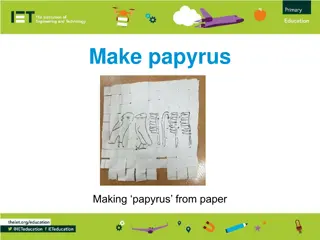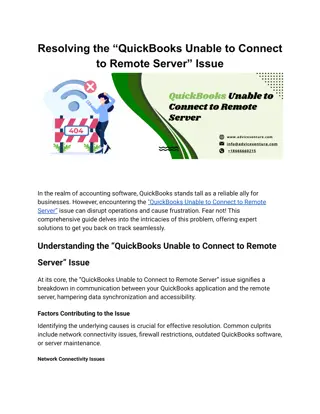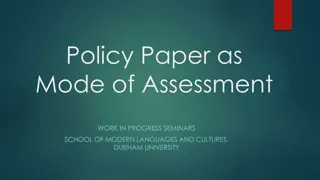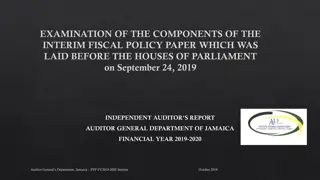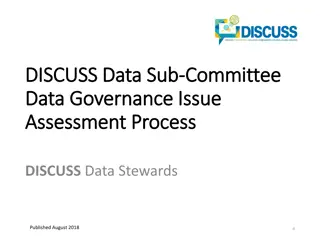
HIV and AIDS Mainstreaming Guidelines in Local Governments Presentation
This paper discusses the importance of HIV and AIDS mainstreaming in local governments, focusing on Uganda's efforts to combat the epidemic. It highlights the decline in HIV prevalence rates and new infections, emphasizing the need for sectorial policies to address the long-term impact of the epidemic. The presentation outlines key steps, priority areas, budget allocation, and coordination structures for mainstreaming HIV and AIDS. Furthermore, it links the guidelines with national commitments to Vision 2040, National Development Plan II, and the National Health Policy, emphasizing the role of all sectors in combating the HIV pandemic.
Download Presentation

Please find below an Image/Link to download the presentation.
The content on the website is provided AS IS for your information and personal use only. It may not be sold, licensed, or shared on other websites without obtaining consent from the author. If you encounter any issues during the download, it is possible that the publisher has removed the file from their server.
You are allowed to download the files provided on this website for personal or commercial use, subject to the condition that they are used lawfully. All files are the property of their respective owners.
The content on the website is provided AS IS for your information and personal use only. It may not be sold, licensed, or shared on other websites without obtaining consent from the author.
E N D
Presentation Transcript
1 Issues Paper on HIV and AIDS Mainstreaming Guidelines in LGs Presentation to the Local Government Budget Consultative Workshops for 2019/20 17thSeptember-2ndOctober, 2018
2 Presentation Outline 1.0 2.0 3.0 Key Steps in HIV and AIDS Mainstreaming 4.0 Priority Areas for Sectorial HIV & AIDS Mainstreaming 5.0 Users of HIV/AIDs Mainstreaming Guidelines 6.0 Budget Allocation for HIV&AIDS Mainstreaming 7.0 Coordination and Management Structures 8.0 Conclusion Background/Introduction Linkage of the Guidelines with the National Commitments
3 1.0 Introduction HIV&AIDS is still a burden in Uganda Threats to Uganda s socio-economic development, imposing a heavy burden on individuals, families, communities and the nation. Uganda is acknowledged as one of the countries that have mounted the most innovative and successful responses against the HIV and AIDS epidemic. The country registered HIV prevalence decline, from 18% in 1990s to 6.4% in 2005 and again after a resurgence of HIV from 7.3% in 2011 to 6% in the general population in 2016 (UPHIA 2016).
4 HIV Prevalence 2011 HIV Prevalence 2016
5 Introduction. Cont . There has been a decline in the number of new infections among both women and men from 2011 to 2017. Among the women it declined from 48,000 in 2011to 19,000, while for men it declined from 35,000 to 18,000 from 2011 and 2017 respectively. HIV& AIDS mainstreaming in Uganda has been considered as an appropriate and sustainable strategy to address the multifaceted drivers and consequences of the epidemic. HIV & AIDS mainstreaming is a process where by a sector analyses how HIV and AIDS can impact it now and in the future, and considers how sectorial policies, decisions and actions might influence the long-term impact of the epidemic in the sector
2.0 Linkage of the Guidelines with the National Commitments Vision 2040: Effective HIV&AIDS mainstreaming at sectorial level will greatly contribute to Vision 2040 by ensuring a healthy population National Development Plan II (NDPII): Recognizes the impact of HIV&AIDS epidemic on the economy to ensure the wellbeing of the population. The National Health Policy (2017): The Health Policy seeks to reach everyone in a comprehensive integrated manner. The guidelines re-emphasize the need for attention by all sectors and development partners in addressing the HIV pandemic.
Linkage cont National HIV&AIDS Strategic Plan 2015/16-2019/20: The NSP positions mainstreaming as part of systems strengthening to ensure sustainability of the response Local Governments Act (1997) - Amendment 2015: to ensure budgets take into account HIV&AIDS in the approved Development Plan of the local government. Presidential Fast Track Initiative on ending AIDS as a Public Health Threat by 2030.To ensure financial sustainability for the HIV response and Institutional effectiveness for a well-coordinated multi-sectoral response
3.0 Key Steps in HIV and AIDS Mainstreaming Step 1: Allocate 0.1% of the Local Government total Budget (excluding pensions, gratuity & transfers) to the HIV&AIDS activities. Step 2: Develop Local Government HIV& AIDS Strategic interventions aligned to the National HIV & AIDS Strategic Plan priorities under the following thematic areas: Prevention, Care and treatment, Social support and protection and System Strengthening Step 3: Implement, document, and report on planned activities on HIV & AIDS mainstreaming and submit reports on a quarterly basis together with other statutory reports to OPM.
4.0 Priority Areas for Sectorial HIV & AIDS Mainstreaming To ensure that all Local Governments implement HIV&AIDS mainstreaming activities in a uniform manner, the following minimum set interventions shall be undertaken; 1. HIV Prevention Interventions: Conduct HIV & AIDS sensitization at the workplace and within communities Conduct/refer clients for HIV testing and counseling services both at workplace and in communities served Promote Behavior Change Communication interventions including dissemination Communication (IEC) materials at the work place and within the communities Promote HIV prevention interventions that focus on adolescent girls and young women. of Information Education
Priority areas cont. Promote correct/consistent communities including establishment of condom dispensers and mechanisms of regular refills Promote access for referral mechanism for Prevention of Mother to Child Transmission (PMTCT) and Safe medical Male Circumcision (SMC) services, Post Exposure Prophylaxis and other approved methods of prevention strategy Engage men in HIV prevention at work place and within the communities served condom education, at distribution workplace and in use the and
Priority areas cont. 2. Care and treatment: Provide effective referrals of staff identified to be living with HIV to access ART. Support all staff and particularly PLHIV staff through medical insurance schemes
Priority areas cont. 3. Social support and Protection: Promote psycho-social support for PLHIV at workplace and within communities served including Home Based Care etc. Establish PLHIV support groups at the workplace and in communities served Establish and strengthen mechanisms to address stigma and discrimination of PLHIV at the workplace and communities served.
Priority areas cont. 4. Systems strengthening: Establish and strengthen coordination structures at district, sub-county, parish and village levels Develop and operationalize HIV & AIDS workplace policy and community regulations Build capacity of staff and community leaders in handling HIV & AIDS related issues at the workplace and community levels Conduct monitoring and evaluation activities including meetings, supervisions, data collection, preparing and submission of activity reports Conduct resource mobilization implementation of sector HIV and AIDS plans activities to ensure
5.0 Users of HIV/AIDS Mainstreaming Guidelines in Local Governments Policy makers (District, Urban Authority and Sub-county Councilors) Accounting Officers, Heads of Departments and Planners in all Local Governments District HIV/AIDS Focal Persons Development/Donor Agencies Decision Makers and Managers in Private sector, and civil society/ NGO personnel
6.0 Budget Allocation for HIV&AIDS Mainstreaming To facilitate implementation of the mainstreaming guidelines, the Ministry of Finance, Planning and Economic Development (MoFPED) in its Second Budget Circular for FY 2018/19 has instructed all MDAs and LGs to allocate 0.1% of their total budget allocation (excluding pension, gratuity and transfers) for HIV&AIDS interventions.
7.0 Coordination and Management Structures Local Governments should establish a Multi-sectoral HIV and AIDS coordination committee of 15 members comprising of members representing departments/ Units of the Local Government to coordinate the mainstreaming of the HIV response. The same should be replicated/Cascaded at the Lower level Governments (Sub-county and Parish) The District Chairperson/ Mayor shall chair the Committee while the Accounting Officers will be the Secretary to the Committee. The Accounting Officer should appoint HIV&AIDS Focal Person, who will be responsible for day-to-day planning, coordination and implementation of the HIV&AIDS activities in the LGs
17 7.0 Coordination and Management Structures (cont.) The Focal Point person will be responsible for day-to-day planning, coordination and implementation of the HIV&AIDS activities in the LGs. The UAC through the Office of the President will provide oversight and technical support for effective HIV &AIDS Mainstreaming in all MDAs/LGs. UAC will also conduct periodic assessments on the status of Implementation of the HIV&AIDS planned activities and budgets in all MDAs/LGs. UAC is in consultation with The Ministry of Finance Planning and Economic Development to create a vote output for HIV&AIDS mainstreaming for MDA/LGs
8.0 Conclusions Mainstreaming HIV&AIDS Key Results Improved Institutional response to HIV&AIDS Sustainable HIV/AIDS financing in the LG Effective coordination structures Monitoring and Evaluation of all HIV & AIDS activities leading to increased knowledge on effective HIV&AIDS responses





